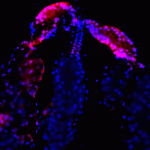Lien vers Pubmed [PMID] – 30359409
Lien DOI – 10.1371/journal.pone.0206093
PLoS One 2018 ; 13(10): e0206093
Zika virus (ZIKV) is an emerging arbovirus of the Flaviviridae family. Although infection with ZIKV generally leads to mild disease, its recent emergence in the Americas has been associated with an increase in the development of the Guillain-Barré syndrome in adults, as well as with neurological complications, in particular congenital microcephaly, in new-borns. To date, little information is available on neuroinflammation induced by ZIKV, notably in microglial cells in the context of their metabolic activity, a series of chemical transformations that are essential for their growth, reproduction, structural maintenance and environmental responses. Therefore, in the present study we investigated the metabolomic profile of ZIKV-infected microglia. Microglial cells were exposed to ZIKV at different time points and were analyzed by a Liquid Chromatography-High Resolution mass spectrometry-based metabolomic approach. The results show that ZIKV infection in microglia leads to modulation of the expression of numerous metabolites, including lysophospholipids, particulary Lysophosphatidylcholine, and phospholipids such as Phosphatidylcholine, Phosphatidylserine, Ceramide and Sphingomyelin, and carboxylicic acids as Undecanedioic and Dodecanedioic acid. Some of these metabolites are involved in neuronal differentiation, regulation of apoptosis, virion architecture and viral replication. ZIKV infection was associated with concomitant secretion of inflammatory mediators linked with central nervous system inflammation such as IL-6, TNF-α, IL-1β, iNOS and NO. It also resulted in the upregulation of the expression of the gene encoding CX3CR1, a chemokine receptor known to regulate functional synapse plasticity and signaling between microglial cells. These findings highlight an important role for microglia and their metabolites in the process of neuroinflammation that occurs during ZIKV pathogenesis.

